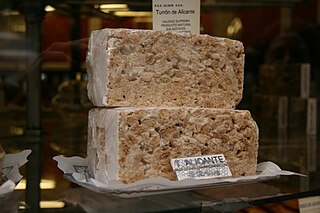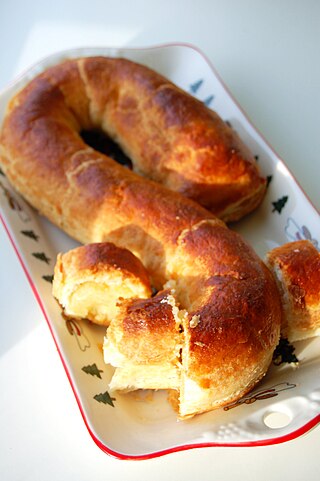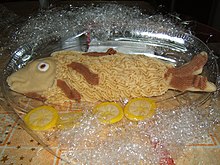
Dessert is a course that concludes a meal. The course consists of sweet foods, such as candy, and possibly a beverage such as dessert wine and liqueur. Some cultures sweeten foods that are more commonly savory to create desserts. In some parts of the world there is no tradition of a dessert course to conclude a meal.

Confectionery is the art of making confections, which are food items that are rich in sugar and carbohydrates. Exact definitions are difficult. In general, however, confectionery is divided into two broad and somewhat overlapping categories: bakers' confections and sugar confections. The occupation of confectioner encompasses the categories of cooking performed by both the French patissier and the confiseur.

A Danish pastry is a multilayered, laminated sweet pastry in the viennoiserie tradition. The concept was brought to Denmark by Austrian bakers, where the recipe was partly changed and accommodated by the Danes to their liking, and has since developed into a Danish specialty. Like other viennoiserie pastries, such as croissants, it is a variant of puff pastry made of laminated yeast-leavened dough that creates a layered texture.

Pralines are confections containing nuts – usually almonds, pecans and hazelnuts – and sugar. Cream is a common third ingredient.

Turrón and torrone is a southwest European nougat confection, typically made of honey, sugar, and egg white, with toasted almonds or other nuts, and usually shaped either into a rectangular tablet or a round cake. Turrón is usually eaten as a dessert food around Christmas in Spain and Italy. It's also known in Portugal and the countries of Latin America.

Marzipan is a confection consisting primarily of sugar, honey, and almond meal, sometimes augmented with almond oil or extract.

A semla, vastlakukkel, laskiaispulla, Swedish eclair, fastlagsbulle/fastelavnsbolle or vēja kūkas is a traditional sweet roll made in various forms in Sweden, Finland, Norway, Denmark, the Faroe Islands, Iceland, Estonia, and Latvia, associated with Lent and especially Shrove Tuesday in most countries, Shrove Monday in Denmark, parts of southern Sweden, Iceland and Faroe Islands or Sunday of Fastelavn in Norway. In Sweden it is most commonly known as just semla, but is also known as fettisdagsbulle, lit. 'Fat Tuesday bun' or 'Shrove Tuesday bun'. In the southern parts of Sweden, as well as in Swedish-speaking Finland, it is known as fastlagsbulle. In Poland it is known as ptyś. In Estonia it is called vastlakukkel. In Norway and Denmark it is called fastelavnsbolle. In Iceland, it is known as a bolla and served on Bolludagur. In Faroe Islands it is called Føstulávintsbolli, and is served on Føstulávintsmánadagur. In Latvia, it is called vēja kūkas. Semla served in a bowl of hot milk is hetvägg.

Icing, or frosting, is a sweet, often creamy glaze made of sugar with a liquid, such as water or milk, that is often enriched with ingredients like butter, egg whites, cream cheese, or flavorings. It is used to coat or decorate baked goods, such as cakes. When it is used between layers of cake it is known as a filling.

Dutch cuisine is formed from the cooking traditions and practices of the Netherlands. The country's cuisine is shaped by its location in the fertile North Sea river delta of the European Plain, giving rise to fishing, farming and overseas trade. The Burgundian-Habsburg court enriched the cuisine of the Dutch elite in the 15th and 16th century, so did the colonial spice trade in the 17th century.

A macaron or French macaroon is a sweet meringue-based confection made with egg white, icing sugar, granulated sugar, almond meal, and often food colouring.

Maamoul is a filled butter cookie made with semolina flour. It is popular throughout the Arab world. The filling can be made with dried fruits like figs or dates or nuts such as pistachios or walnuts and occasionally almonds.

Qurabiya, is a shortbread-type biscuit, usually made with ground almonds. Versions are found in most Arab and Ottoman cuisines, with various different forms and recipes. They are similar to polvorones from Andalusia.
Semmelwrap is a Swedish pastry.

The Dutch letter is a type of pastry that is typically prepared using a mixture of flour, eggs and butter or puff pastry as its base and filled with almond paste, dusted with sugar and shaped in an "S" or other letter shape. Marzipan, an almond paste prepared with almond meal and honey or sugar, is sometimes used as the filling. The Dutch letter has a porous or airy and flaky texture.
Impade is a cookie of Sephardi Jewish origin that is most commonly found among members of the Venetian Jewish community and their descendants, and is traditionally prepared at Purim, but is also prepared year round.















